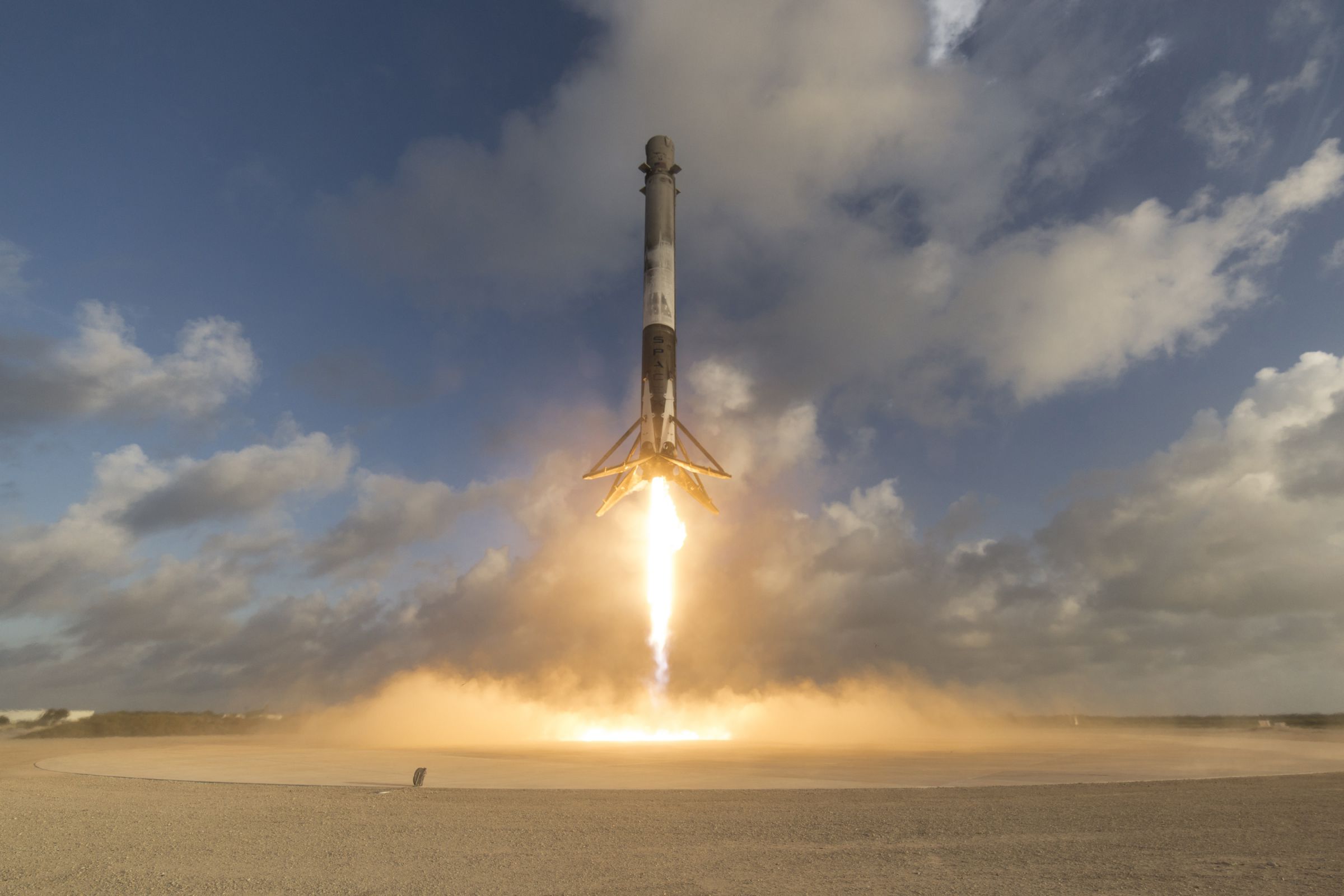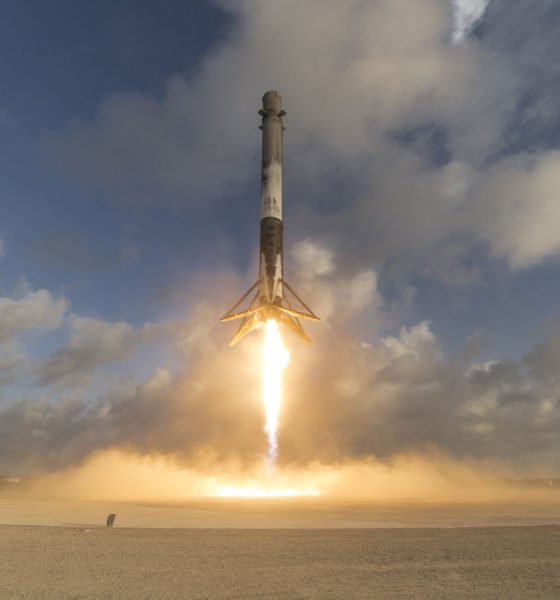

News
SpaceX’s mystery October launch identified as a US spy satellite
A week after signs of the mission first appeared, the National Reconnaissance Office (NRO) has confirmed that SpaceX’s mystery October launch will carry a new spy satellite.
Known as NROL-108, the mission is intriguing for several reasons, ranging from its implied launch trajectory, the rocket likely to launch it, and the secrecy surrounding it. While both NRO satellite launches and what the agency generally does are both highly secretive, it’s still extremely uncommon for a US government launch of any kind to remain secret just one month prior to liftoff.
For SpaceX, the mysterious Zuma mission is the only US mission in recent memory to top the level of secrecy NROL-108 is shrouded in, remaining essentially unannounced and unclaimed by any government agency before, during, and after launch. However, a separate launch completed around half a year prior to Zuma helps shed light on SpaceX’s latest surprise contract.

The only mission NROL-108 is reminiscent of is actually SpaceX’s first launch for the NRO – NROL-76. Launched in May 2017, the payload – believed to be involved in some kind of Low Earth Orbit (LEO) test of proximity operations – remains classified and almost entirely a mystery to this day. The most notable thing about the mission was the fact that the spacecraft repeatedly made close passes to the International Space Station (ISS) – incredibly unusual insofar as NASA and Russia retain strict control over what can and cannot approach the crewed outpost.
Like NROL-76, NROL-108 will launch on a Falcon 9 rocket, while the mission’s booster will be permitted to attempt a return-to-launch-site (RTLS) landing back on land. For Falcon 9, an RTLS booster landing fundamentally implies that the payload launched is lightweight, heading to LEO, or some combination of the two. While NROL-76 was similar in that regard, the NRO revealed NROL-76 and confirmed that SpaceX would launch the mission a full 10 months prior to the launch date.
For NROL-108, the NRO only confirmed its SpaceX launch plans after FCC documents revealed some kind of mystery mission scheduled in October 2020. Even for the NRO, revealing a launch less than a month prior to liftoff is thoroughly abnormal.
Also abnormal: barring SpaceX managing to somehow slip an entire building-sized Falcon 9 booster from Los Angeles to Cape Canaveral, NROL-108 will likely mark the espionage agency’s inaugural launch on a commercial flight-proven rocket. SpaceX technically has at least three new Falcon 9 boosters in various stages of preparation for NASA and US military launches in October TBD (GPS III SV04) and November (Crew-1, Sentinel 6A) but all three are firmly spoken for.
According to the NRO’s official confirmation with SpaceflightNow, a SpaceX Falcon 9 rocket is scheduled to launch NROL-108 no earlier than (NET) October 25th. The company is faced with an expansive Q4 2020 manifest, including GPS III SV04 (October TBD), Sirius XM’s newest radio satellite (NET early November), the Sentinel 6A oceanography satellite (NET November 10th), Crew Dragon’s first operational astronaut launch (NET mid November), the first launch of Cargo Dragon 2 (NET November 22nd), a Turkish communications satellite (NET November 30th), and several more Starlink missions.
Check out Teslarati’s Marketplace! We offer Tesla accessories, including for the Tesla Cybertruck and Tesla Model 3.

News
Ford cancels all-electric F-150 Lightning, announces $19.5 billion in charges
“Rather than spending billions more on large EVs that now have no path to profitability, we are allocating that money into higher returning areas, more trucks and van hybrids, extended range electric vehicles, affordable EVs, and entirely new opportunities like energy storage.”

Ford is canceling the all-electric F-150 Lightning and also announced it would take a $19.5 billion charge as it aims to quickly restructure its strategy regarding electrification efforts, a massive blow for the Detroit-based company that was once one of the most gung-ho on transitioning to EVs.
The announcement comes as the writing on the wall seemed to get bolder and more identifiable. Ford was bleeding money in EVs and, although it had a lot of success with the all-electric Lightning, it is aiming to push its efforts elsewhere.
It will also restructure its entire strategy on EVs, and the Lightning is not the only vehicle getting the boot. The T3 pickup, a long-awaited vehicle that was developed in part of a skunkworks program, is also no longer in the company’s plans.
Instead of continuing on with its large EVs, it will now shift its focus to hybrids and “extended-range EVs,” which will have an onboard gasoline engine to increase traveling distance, according to the Wall Street Journal.
“Ford no longer plans to produce select larger electric vehicles where the business case has eroded due to lower-than-expected demand, high costs, and regulatory changes,” the company said in a statement.
🚨 Ford has announced it is discontinuing production of the F-150 Lightning, as it plans to report a charge of $19.5 billion in special items.
The Lightning will still be produced, but instead with a gas generator that will give it over 700 miles of range.
“Ford no longer… pic.twitter.com/ZttZ66SDHL
— TESLARATI (@Teslarati) December 15, 2025
While unfortunate, especially because the Lightning was a fantastic electric truck, Ford is ultimately a business, and a business needs to make money.
Ford has lost $13 billion on its EV business since 2023, and company executives are more than aware that they gave it plenty of time to flourish.
Andrew Frick, President of Ford, said:
“Rather than spending billions more on large EVs that now have no path to profitability, we are allocating that money into higher returning areas, more trucks and van hybrids, extended range electric vehicles, affordable EVs, and entirely new opportunities like energy storage.”
CEO Jim Farley also commented on the decision:
“Instead of plowing billions into the future knowing these large EVs will never make money, we are pivoting.”
Farley also said that the company now knows enough about the U.S. market “where we have a lot more certainty in this second inning.”
News
SpaceX shades airline for seeking contract with Amazon’s Starlink rival

SpaceX employees, including its CEO Elon Musk, shaded American Airlines on social media this past weekend due to the company’s reported talks with Amazon’s Starlink rival, Leo.
Starlink has been adopted by several airlines, including United Airlines, Qatar Airways, Hawaiian Airlines, WestJet, Air France, airBaltic, and others. It has gained notoriety as an extremely solid, dependable, and reliable option for airline travel, as traditional options frequently cause users to lose connection to the internet.
Many airlines have made the switch, while others continue to mull the options available to them. American Airlines is one of them.
A report from Bloomberg indicates the airline is thinking of going with a Starlink rival owned by Amazon, called Leo. It was previously referred to as Project Kuiper.
American CEO Robert Isom said (via Bloomberg):
“While there’s Starlink, there are other low-Earth-orbit satellite opportunities that we can look at. We’re making sure that American is going to have what our customers need.”
Isom also said American has been in touch with Amazon about installing Leo on its aircraft, but he would not reveal the status of any discussions with the company.
The report caught the attention of Michael Nicolls, the Vice President of Starlink Engineering at SpaceX, who said:
“Only fly on airlines with good connectivity… and only one source of good connectivity at the moment…”
CEO Elon Musk replied to Nicolls by stating that American Airlines risks losing “a lot of customers if their connectivity solution fails.”
American Airlines will lose a lot of customers if their connectivity solution fails
— Elon Musk (@elonmusk) December 14, 2025
There are over 8,000 Starlink satellites in orbit currently, offering internet coverage in over 150 countries and territories globally. SpaceX expands its array of satellites nearly every week with launches from California and Florida, aiming to offer internet access to everyone across the globe.
Currently, the company is focusing on expanding into new markets, such as Africa and Asia.
News
Tesla Model Y Standard stuns in new range test, besting its Premium siblings
Tesla’s newer vehicles have continued to meet or exceed their EPA estimates. This is a drastic change, as every 2018-2023 model year Tesla that Edmunds assessed did not meet its range estimates.

The Tesla Model Y Standard stunned in a new range test performed by automotive media outlet Edmunds, besting all of its Premium siblings that are more expensive and more luxurious in terms of features.
Testing showed the Model Y Standard exceeded its EPA-estimated range rating of 321 miles, as Edmunds said it is the “longest-range Model Y that we’ve ever put on our loop.” In the past, some vehicles have come up short in comparison with EPA ranges; for example, the Model Y’s previous generation vehicle had an EPA-estimated range of 330 miles, but only drove 310.
Additionally, the Launch Series Model Y, the first configuration to be built in the “Juniper” program, landed perfectly on the EPA’s range estimates at 327 miles.
It was also more efficient than Premium offerings, as it utilized just 22.8 kWh to go 100 miles. The Launch Series used 26.8 kWh to travel the same distance.
It is tested using Edmunds’ traditional EV range testing procedure, which follows a strict route of 60 percent city and 40 percent highway driving. The average speed throughout the trip is 40 MPH, and the car is required to stay within 5 MPH of all posted speed limits.
Each car is also put in its most efficient drive setting, and the climate is kept on auto at 72 degrees.
“All of this most accurately represents the real-world driving that owners do day to day,” the publication says.
With this procedure, testing is as consistent as it can get. Of course, there are other factors, like temperature and traffic density. However, one thing is important to note: Tesla’s newer vehicles have continued to meet or exceed their EPA estimates. This is a drastic change, as every 2018-2023 model year Tesla that Edmunds assessed did not meet its range estimates.
Tesla Model Y Standard vs. Tesla Model Y Premium
Tesla’s two Model Y levels both offer a great option for whichever fits your budget. However, when you sit in both cars, you will notice distinct differences between them.
The Premium definitely has a more luxurious feel, while the Standard is stripped of many of the more premium features, like Vegan Leather Interior, acoustic-lined glass, and a better sound system.
You can read our full review of the Model Y Standard below:
Tesla Model Y Standard Full Review: Is it worth the lower price?








